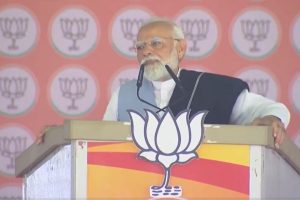With more boisterous issues hogging the headlines in the last couple of months, Prime Minister Narendra Modi’s Skill India campaign has been somehow overshadowed in the popular discourse. But its importance in addressing the country’s massive skill gap cannot be overstated.
The Harvard University South Asia Institute along with Tata Trusts undertook an 18-month research project called “Livelihood Creation in India through Social Entrepreneurship and Skill Development” from August 2015 to December 2016. As part of the project, 16 organisations were given social innovation grants totalling Rs 50 lakh and their proposals were implemented during the later stages of 2016. Six publications documenting various aspects of their research have also been published.
Shashank Shah, project director and fellow, Harvard University South Asia Institute and visiting scholar, Harvard Business School, spoke about how it all came about, the insights gained during the course of the project and the future of skills development in India. Excerpts:
Q. How did the idea for the project come about?
According to a survey of skills gap by the National Skills Development Corporation, over the next decade, Indian industry needs 240 million people just to maintain the current growth rate. The entire Indian education system produces only about 12 million graduates, and another 4.3 million people who emerge from the education system as skilled people every year. Of these, many people are not employable due to poor quality of skill sets or lack of relevant vocational training.
According to a Labour Ministry Report, in 2012-13, one out of every three persons in the age group of 15 to 29 years, who have completed at least their graduation, was found to be unemployed. Of the unemployed in this age group, 36.6 per cent were in the rural areas and 26.5 per cent in urban areas.
It is in this context that this project on “Livelihood Creation in India through Social Entrepreneurship and Skill Development” was envisaged as a collaborative endeavour between the Tata Trusts and the Harvard University South Asia Institute. The project aimed at providing the much needed platform to bring in international expertise and knowledge from the diverse faculties of Harvard University.
The collaboration between Harvard and local subject experts aimed at catalysing the process of creating livelihoods thereby contributing to social and economic empowerment of the vulnerable sections of India. The large canvas and support provided by the Government of India machinery and the Skill India campaign envisaged by the Prime Minister emerged as a very timely opportunity to contribute towards poverty alleviation and human development through the route of social entrepreneurship and skill development.
Q. Why did you specifically focus on the handicrafts and handloom sectors?
The production of handicrafts is (after agriculture) the largest source of income among rural populations — an estimated 11.65 million Indians were engaged in craft production in 2013. This is expected to grow to 17.79 million by 2022. Data from unofficial sources indicate that up to 200 million craftspeople or artisans directly and indirectly depend on this sector for a livelihood, suggesting the need for a more rigorous mapping and understanding of the sector. Hence, this project aimed at providing that support and addressed the challenges currently faced by enterprises that seek to improve rural livelihoods in the handicrafts and handloom sectors. The specific locus of Harvard South Asia Institute’s intervention was the rich and varied Indian handicraft tradition, practiced by skilled rural artisans, who produce objects of great beauty with strong market potential. The goal of this project was to provide tangible and intangible inputs to augment the capacity for impact of a select set of organisations working in the field to improve the lives and livelihoods of India’s handicraft and handloom artisans.
Q. What are some of the key insights you’ve gained through the project?
During our field research and from responses received from over 400 applicants, we realised the capacity gaps that existed in the leaders of these organisations. Through the workshops, we focused on delivering these through inputs from subject experts from India, and Harvard cases taught by Harvard faculty who led these workshops.
The top three capacity gaps in Indian crafts entrepreneurs were found to be market access and marketing; scaling up and strategy, and finance. On the other hand, the top three capacity gaps in science and tech-based social entrepreneurs were partnerships and networking; mentoring and expertise, and programme/product management.
Q. Have you shared your research with the government? What is their response?
We have shared our publications with select government agencies. We also invited select government representatives to share their insights with our grantees during the workshops and the summative events. For example, Manish Kumar, managing director, National Skills Development Corporation, and Vijaya Raghavan, secretary, department of biotechnology, delivered the keynote and valedictory addresses at the Summit event held on 23 January.
Q. What is the “All India Arts Alliance” and how will it work?
One of the major gaps noticed by the participants of the crafts track was the lack of a platform to share their ideas, concerns and innovations as a collective entity. Consequently, the 52 organisations that participated at the crafts workshop in January 2016, ideated and volunteered to form an alliance that would serve this purpose. After year-long deliberations, the alliance was launched at the Harvard SAI summit event.
Ihitiashri Shandilya, chief executive officer, MithilAsmita, took on the mantle as the coordinator of this alliance. Harvard SAI has no direct role to play in this alliance. We were happy to provide an ecosystem where the crafts entrepreneurs could interact and ideate to initiate and implement such an alliance.
Q. What more can be done for skill development and livelihood creation in India?
In my understanding, there exists a tremendous opportunity to build capacity in the leaders of social enterprises such that it catalyses their institution’s growth, and also impacts and empowers the rural artisans. For example, by providing capacity building to the 52 crafts enterprises’ leaders through our workshop, we indirectly impacted 180,000 rural artisans they were working with.
I believe that academic institutions, civil society organisations and corporations can work together to contribute to livelihood creation in India through skills training. The CSR legislation also provides an opportunity to corporations to fund capacity building for NGOs.
The academic institutions can bring to play their research-based insights and frame multi-perspective curricula to contribute to the widening of horizons and inculcate virtues of effectiveness and efficiency, innovation and impact-orientation in these organisations.
Skills development and livelihood creation in India received a major fillip thanks to Harvard University South Asia Institute for conducting the research.
To know more about the project, grantees and publications,check out http://southasiainstitute.harvard.edu/ about-livelihood-creation-project











